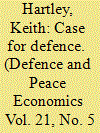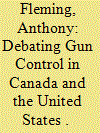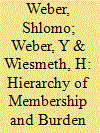|
|
|
Sort Order |
|
|
|
Items / Page
|
|
|
|
|
|
|
| Srl | Item |
| 1 |
ID:
178658


|
|
|
|
|
| Summary/Abstract |
This paper closely scrutinises NATO engagement, particularly the The Eastern Flank countries in the Middle East. Our main argument is that the quantitative approach to free riding is useful only when it comes to black-and-white policy choices and either-or policy decisions. Simultaneously, it fails when we are faced with more complex situations in which evaluations go beyond the very simple numerical markers, such as the 2% threshold of defence spending. By bringing together a unique regional focus (the European East and the Middle East), theoretical dilemmas (free-riding) and policy issues (NATO's multilateral framework of co-operation understood in terms of strategic interests and practical engagement), we are able to show that Romania is a subtle free rider, which cannot be verified by merely looking at numbers alone, but can be ascertained by a careful qualitative analysis which reveals a discrepancy between the country's strategic interests and its level of engagement.
|
|
|
|
|
|
|
|
|
|
|
|
|
|
|
|
| 2 |
ID:
100954


|
|
|
|
|
| Publication |
2010.
|
| Summary/Abstract |
What is the case for defence and is it a worthwhile investment? This question is addressed for two contrasting nations, namely, the UK and New Zealand. Economists have a set of standard analytical tools for addressing the question but they are difficult to operationalise. This paper provides policy-relevant answers.
|
|
|
|
|
|
|
|
|
|
|
|
|
|
|
|
| 3 |
ID:
089555


|
|
|
|
|
| Publication |
2009.
|
| Summary/Abstract |
This paper applies a common-agency model to demonstrate why recent enterprise reforms that assign the State Asset Supervision and Administration Commission (SASAC) a greater role in running China's state-owned enterprises (SOEs) are apt to fail. In a theoretical framework, we show that local principals' incentive payments are likely to clash with those of SASAC as local SOE principals' promote social stability and SASAC bolsters SOE efficiency. A second-best outcome requires a social planner to restrict actions by local principals and to impose taxes/subsidies to address inter-principal externalities. In the long run, the simplest solution is to privatize SOEs and find a public-sector funding source for promoting social stability.
|
|
|
|
|
|
|
|
|
|
|
|
|
|
|
|
| 4 |
ID:
163914


|
|
|
|
|
| Summary/Abstract |
The weakness of the antigun lobby in the United States is attributed to the “collective action problem” of trying to mobilize “free riders” behind a public purpose. But the Coalition for Gun Control emerged in Canada to successfully lobby for the Firearms Act of 1995. If the “collective action problem” is not limited to the United States, then are its effects “mediated” by political culture? To address this research question, we content analyze (1) media coverage, (2) party platforms, (3) presidential, and (4) ministerial rhetoric. Three frames represent “restrictive” gun policies that ban or regulate firearms, “punitive” gun policies that penalize the person for the unlawful use of firearms, or “lenient” gun policies that encourage gun ownership and gun rights. Marked differences in framing the gun debate help explain why an antigun coalition emerged in Canada but not the United States.
|
|
|
|
|
|
|
|
|
|
|
|
|
|
|
|
| 5 |
ID:
191916


|
|
|
|
|
| Summary/Abstract |
How do states distribute the burdens of collective defense? This paper develops a network theory of burden sharing. We focus on bilateral defense cooperation agreements (DCAs), which promote cooperation in a variety of defense, military, and security issue areas. Using a computational model, we show that DCA partners’ defense spending depends on the network structure of their agreements. In bilateral terms, DCAs increase defense spending by committing states to defense activities and allowing partners to reciprocally punish free riding. However, as a state's local network of defense partnerships grows more densely connected, with many transitive “friend of a friend” relations, DCAs have the countervailing effect of reducing defense spending. The more deeply integrated states are in bilateral defense networks, the less they spend on defense. We distinguish two potential mechanisms behind this effect—one based on efficiency improvements, the other on free riding. An empirical analysis using multilevel inferential network models points more to efficiency than to free riding. Defense networks reduce defense spending, and they do so by allowing countries to produce security more efficiently.
|
|
|
|
|
|
|
|
|
|
|
|
|
|
|
|
| 6 |
ID:
182553


|
|
|
|
|
| Summary/Abstract |
We examine a military alliance with heterogeneous members that finances the production of the ‘alliance good’ (defense, deterrence, and peacekeeping) through its members’ voluntary contributions. To examine the patterns of those contributions, we introduce a decision-making model with three layers of hierarchy: one ‘super-leader’, a group of ‘leaders’, and several ‘followers’, which takes into account different economic and historical backgrounds of member states. The asymmetric interaction between the members is reflected by the choice of Stackelberg paradigm where the sequence of countries’ moves is determined by their alliance status. We then apply Penrose’s Law to incorporate countries’ heterogeneous population sizes in our model and show the existence of a unique Penrose-Stackelberg equilibrium. We apply our results to NATO and offer an empirical evaluation of burden sharing across the alliance by showing how economic characteristics, alliance ‘awareness’, and the alliance status explain the patterns of members’ contributions. We also evaluate the optimal fit between the data and an appropriate choice of the alliance’s hierarchical structure.
|
|
|
|
|
|
|
|
|
|
|
|
|
|
|
|
| 7 |
ID:
172142


|
|
|
|
|
| Summary/Abstract |
For 2011–2017, this paper revisits NATO burden sharing in light of recent developments and pledges to bolster members’ defense shares of GDP to 2%. Russian nationalism, enhanced transnational terrorism, and intrastate conflicts are apt to increase the publicness of NATO defense spending over the last eight years. When NATO allies’ defense shares of GDP are correlated with their GDP ranks, there is clear evidence of the exploitation of the large, rich allies by the small, poor allies, indicative of allies sharing purely public defense spending since 2011. Such exploitation and free riding has rarely been seen after 1967. In addition, there is an absence of concordance between NATO allies’ defense burdens and their derived benefit shares, consistent with greater defense publicness. Finally, we find further proof of exploitation and free riding for a broad-based measure of security spending.
|
|
|
|
|
|
|
|
|
|
|
|
|
|
|
|
|
|
|
|
|